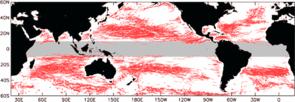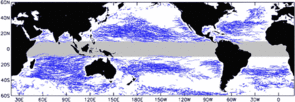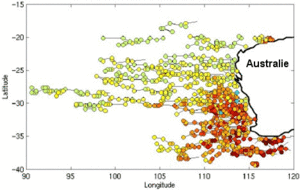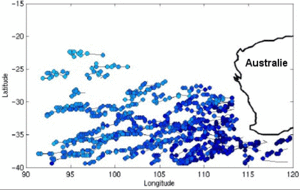Altimetry on eddies' tracks
Eddies's distribution around the world
Analysis of Sea Level Anomalies from merged satellite data, now available for more than ten years, reveals the areas of high eddy activity, the number of eddies during those years, their size and height. Such a census helps understand ocean dynamics due to features of such size as eddies, and to discriminate eddies'effect from other processes (like the Rossby waves). Some regions see more anticyclonic eddies (positive sea level anomalies), like the Tehuantepec and Papagayo eddy area, others more cyclonic eddies, like the Humbold current.
Anticyclonic (top) and cyclonic (bottom) eddies with lifetimes longer than 18 weeks tracked from altimetry data. Both kinds are moving westwards, with respectively a slight (less than 10°) equatorward and a slight poleward tendency. Some regions see more anticyclonic eddies (e.g. West of Central America, the Tehuantepec and Papagayo eddy area), others more cyclonic eddies (e.g. Humbold current, along the Pacific coasts of South America). In the most active regions, like the Gulf Stream, the eddies lifespan are often quite short, and thus relatively few of them appear on the figures.
(Credits Oregon State University)
Eddies heat
Heat is moved by the mean ocean circulation - the classical currents e.g. the Gulf Stream, Kuroshio etc. But heat transport is also made by eddies, and those induce variations in that transport, which in turn can cause climate variations.
At mid-latitudes, warm eddies go to the equator, cold ones to the pole! At least, between 25 to 40° of latitude, when other factors (bathymetry, strong currents) are not involved, eddies of more than 100 km in diameter tend to go toward the equator when they are anticyclonics (warm eddies, counter-clockwise in Southern hemisphere), and toward the pole when they are cyclonic (cold eddies) under Coriolis force effect.
This tendency, due to turbulences at the eddies' borders, could only be one of nature's oddities. In fact, such mechanisms are probably involved in heat and salinity transports in the ocean.









